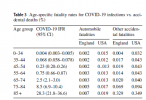Eddy Edson
Well-Known Member
- Relationship to Diabetes
- Type 2
Just published. No big surprises but I think the most comprehensive meta-analysis so far.

 link.springer.com
link.springer.com
Our analysis finds a exponential relationship between age and IFR for COVID-19. T.... Moreover, our results indicate that about 90% of the variation in population IFR across geographical locations reflects differences in the age composition of the population and the extent to which relatively vulnerable age groups were exposed to the virus. These results indicate that COVID-19 is hazardous not only for the elderly but also for middle-aged adults, for whom the infection fatality rate is two orders of magnitude greater than the annualized risk of a fatal automobile accident and far more dangerous than seasonal influenza. Moreover, the overall IFR for COVID-19 should not be viewed as a fixed parameter but as intrinsically linked to the age-specific pattern of infections. Consequently, public health measures to mitigate infections in older adults could substantially decrease total deaths.
A summary table:

IFR for seasonal 'flu is something less than 0.1% so for anybody aged ~45 or older, COVID-19 is a much bigger worry.
And for anybody who was still wondering, if you get COVID-19 you're way, way more likely to die from it than from a traffic or any other kind of accident.
By now, the general message should be clear: if you want to avoid lots of deaths, keep COVID-19 out of aged care settings.
Also, bodies like the LSE and the LSHTM keep putting out studies supposed to inform public policy which really don't take these factors into account, apart from a brief hand-wave; eg, inferring country infection rates from COVID-19 fatality rates by applying fixed one-size-fits-all IFR's. They should focus less on fiddling around with algorithms and more on actual data science.

Assessing the age specificity of infection fatality rates for COVID-19: systematic review, meta-analysis, and public policy implications - European Journal of Epidemiology
Determine age-specific infection fatality rates for COVID-19 to inform public health policies and communications that help protect vulnerable age groups. Studies of COVID-19 prevalence were collected by conducting an online search of published articles, preprints, and government reports that...
Our analysis finds a exponential relationship between age and IFR for COVID-19. T.... Moreover, our results indicate that about 90% of the variation in population IFR across geographical locations reflects differences in the age composition of the population and the extent to which relatively vulnerable age groups were exposed to the virus. These results indicate that COVID-19 is hazardous not only for the elderly but also for middle-aged adults, for whom the infection fatality rate is two orders of magnitude greater than the annualized risk of a fatal automobile accident and far more dangerous than seasonal influenza. Moreover, the overall IFR for COVID-19 should not be viewed as a fixed parameter but as intrinsically linked to the age-specific pattern of infections. Consequently, public health measures to mitigate infections in older adults could substantially decrease total deaths.
A summary table:

IFR for seasonal 'flu is something less than 0.1% so for anybody aged ~45 or older, COVID-19 is a much bigger worry.
And for anybody who was still wondering, if you get COVID-19 you're way, way more likely to die from it than from a traffic or any other kind of accident.
By now, the general message should be clear: if you want to avoid lots of deaths, keep COVID-19 out of aged care settings.
Also, bodies like the LSE and the LSHTM keep putting out studies supposed to inform public policy which really don't take these factors into account, apart from a brief hand-wave; eg, inferring country infection rates from COVID-19 fatality rates by applying fixed one-size-fits-all IFR's. They should focus less on fiddling around with algorithms and more on actual data science.
